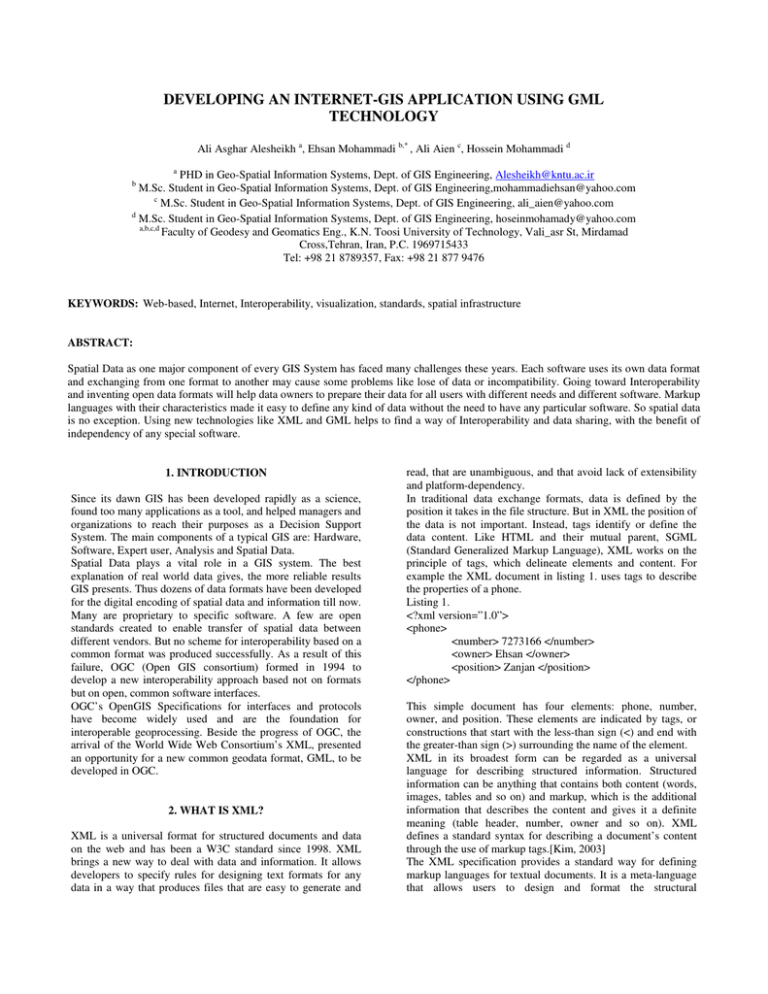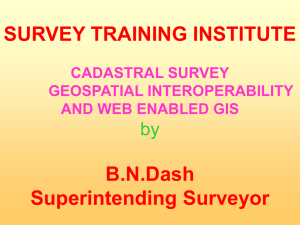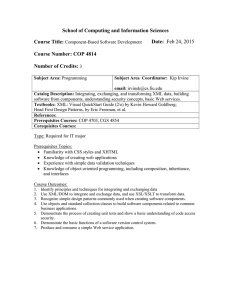DEVELOPING AN INTERNET-GIS APPLICATION USING GML TECHNOLOGY
advertisement

DEVELOPING AN INTERNET-GIS APPLICATION USING GML TECHNOLOGY Ali Asghar Alesheikh a, Ehsan Mohammadi b,* , Ali Aien c, Hossein Mohammadi d a PHD in Geo-Spatial Information Systems, Dept. of GIS Engineering, Alesheikh@kntu.ac.ir M.Sc. Student in Geo-Spatial Information Systems, Dept. of GIS Engineering,mohammadiehsan@yahoo.com c M.Sc. Student in Geo-Spatial Information Systems, Dept. of GIS Engineering, ali_aien@yahoo.com d M.Sc. Student in Geo-Spatial Information Systems, Dept. of GIS Engineering, hoseinmohamady@yahoo.com a,b,c,d Faculty of Geodesy and Geomatics Eng., K.N. Toosi University of Technology, Vali_asr St, Mirdamad Cross,Tehran, Iran, P.C. 1969715433 Tel: +98 21 8789357, Fax: +98 21 877 9476 b KEYWORDS: Web-based, Internet, Interoperability, visualization, standards, spatial infrastructure ABSTRACT: Spatial Data as one major component of every GIS System has faced many challenges these years. Each software uses its own data format and exchanging from one format to another may cause some problems like lose of data or incompatibility. Going toward Interoperability and inventing open data formats will help data owners to prepare their data for all users with different needs and different software. Markup languages with their characteristics made it easy to define any kind of data without the need to have any particular software. So spatial data is no exception. Using new technologies like XML and GML helps to find a way of Interoperability and data sharing, with the benefit of independency of any special software. 1. INTRODUCTION Since its dawn GIS has been developed rapidly as a science, found too many applications as a tool, and helped managers and organizations to reach their purposes as a Decision Support System. The main components of a typical GIS are: Hardware, Software, Expert user, Analysis and Spatial Data. Spatial Data plays a vital role in a GIS system. The best explanation of real world data gives, the more reliable results GIS presents. Thus dozens of data formats have been developed for the digital encoding of spatial data and information till now. Many are proprietary to specific software. A few are open standards created to enable transfer of spatial data between different vendors. But no scheme for interoperability based on a common format was produced successfully. As a result of this failure, OGC (Open GIS consortium) formed in 1994 to develop a new interoperability approach based not on formats but on open, common software interfaces. OGC’s OpenGIS Specifications for interfaces and protocols have become widely used and are the foundation for interoperable geoprocessing. Beside the progress of OGC, the arrival of the World Wide Web Consortium’s XML, presented an opportunity for a new common geodata format, GML, to be developed in OGC. 2. WHAT IS XML? XML is a universal format for structured documents and data on the web and has been a W3C standard since 1998. XML brings a new way to deal with data and information. It allows developers to specify rules for designing text formats for any data in a way that produces files that are easy to generate and read, that are unambiguous, and that avoid lack of extensibility and platform-dependency. In traditional data exchange formats, data is defined by the position it takes in the file structure. But in XML the position of the data is not important. Instead, tags identify or define the data content. Like HTML and their mutual parent, SGML (Standard Generalized Markup Language), XML works on the principle of tags, which delineate elements and content. For example the XML document in listing 1. uses tags to describe the properties of a phone. Listing 1. <?xml version=”1.0”> <phone> <number> 7273166 </number> <owner> Ehsan </owner> <position> Zanjan </position> </phone> This simple document has four elements: phone, number, owner, and position. These elements are indicated by tags, or constructions that start with the less-than sign (<) and end with the greater-than sign (>) surrounding the name of the element. XML in its broadest form can be regarded as a universal language for describing structured information. Structured information can be anything that contains both content (words, images, tables and so on) and markup, which is the additional information that describes the content and gives it a definite meaning (table header, number, owner and so on). XML defines a standard syntax for describing a document’s content through the use of markup tags.[Kim, 2003] The XML specification provides a standard way for defining markup languages for textual documents. It is a meta-language that allows users to design and format the structural relationships for their documents using strict lexical and syntactical constraints. XML documents are stored in plain test, which introduces numerous beneficial consequences. Because XML is human-readable, a plain text editor can be used to view documents. It is also easily transmitted across platforms and over the Internet. In addition, plain text is vendor-neutral, so information that is stored in XML is not locked into a proprietary binary format. A popular use of XML in industry today is that of an intermediary format to enable information sharing between software applications. Data and content stored somewhere in a native format can be converted to an XML format. After it is in XML format, any other external program that understands XML can use the data, possibly converting it back to its own native format if required. Text Binary XML Script DB Fig 1. XML as a Transformation Intermediary 3. XSL IN XML TRANSFORMATION XML uses XSL (eXtensible Stylesheet Language) to transform contained data to other formats. XSL is a transformation and formatting language based on XML. XSL, developed by W3C is used to define a style for formatting or otherwise transforming an XML document. Looked at another way, an XML document is tree-structured and can be parsed and transformed into another tree programmatically. XSL defines programmatic XML transformation. Supporting multi-lingual documents and so on. 5. WHAT IS GML? GML is an XML-based data format for the transport and storage of geographic information. As with other XML variants, specific tags and attributes can be added to easily extend GML, and GML can be validated, processed and displayed using standard XML tools. Just as XML helps to clearly separate content from presentation, GML aims to separate geographic content (data) from geographic presentation (maps and diagrams). GML uses the W3C XML Schema Definition Language to define and constrain the contents of its XML documents. The GML specification defines some basic conformance requirements for users to develop their own application schemas. Software application attempting to process any arbitrary GML user application schema must understand GML and all the technologies upon which GML depends, including W3C XML schema. GML introduces an extraordinary flexibility by letting users define their own application schemas suitable for their own domains; however, this same flexibility also presents a substantial difficulty for writing GML software applications. Just as XML is now helping the web in general to clearly separate content from presentation, GML does the same in the world of geography. It is important for GML data to represent the world in terms that are independent of any particular visualization of that data. It is important to draw clear distinctions between geographic data and graphic interpretation of that data, such as maps. GML captures information about the properties and geometry of the objects that populate the world. Symbolizing the geographic data on map, the colors or line weights and etc. are something quite different. To make a map from GML, it is needed only to style the GML elements into a form that can be interpreted for geographic display in a web browser. Potential graphical display formats include W3C Scalable Vector Graphics (SVG), Vector Markup Language (VML) and the web 3D Consortium’s X3D. [Lake, 2000] 4. BENEFITS OF USING XML 6. A COMPARISON BETWEEN GML AND OTHER FORMATS Most large enterprises expand significant portions of their IT (Information Technology) budget on developing methods to transfer information between isolated systems. XML helps to solve this problem by providing a flexible, platform independent way of transferring data over standard network protocols. Data that is being transferred between systems can be easily translated to and from a standard XML format, by providing a well-known, easy to use, intermediary format. XML helps avoid the need for constantly linking different systems to each others in ‘point-to-point’ solutions. Some other benefits of XML are: Simplicity Openness Extensibility Self-description To compare GML with other spatial data formats, three maps were produced from a unique source. These three maps were prepared for one of the Iranian provinces called Zanjan. First map was generated in Esri’s ArcView and included tree files which represent a shapefile (*.shx, *.shp, *.dbf). Second map was in GML format. This map was rendered using a GML Viewer from eSpatial. And finally the third map was in SVG format and included both graphic and attributes of features and was displayed in Internet Explorer equipped with Adobe SVG Viewer plug-in. All three maps presented same data, but the size of occupied memory is different. For the shape file the size is the smallest, and for GML is the biggest. The reason refers to including both tags and data in GML file. Also text-based files are usually larger than binary files, so is GML. Using SVG simplifies showing any layers of spatial data in web and adding different functionalities and applications. Doing the same things, by using traditional Web-GIS technologies would cost a lot of time and skill, although the final result would not be as good as SVG. 8. CONCLUSION Fig 2. First map in shapefile format Going toward XML technology and the GML in the world of geospatial data and also using SVG is a new approach that overcomes a lot of existing problems. Some of the perspectives that these new technologies show are: XML is a new way to go toward interoperability. Then there is no need to use specific software for existing data. XML simplifies data exchange. GML as an XML-based language is a new approach for spatial data interoperability. GML can be regarded as a promising technology for spatial data transformation. GML presents vector maps. These maps have better quality than those in raster image formats. 9. REFERENCES Kim Larry, 2003, “the official xmlspy handbook”, Wiley. Fig 3. Second map in GML format Lake Ron, 2000, “Making Maps with Geography Markup Language”. 10. ACKNOWLEGEMENT Our best appreciation is dedicated to those who help us through implementing the programs and guide us to understand GML. Fig 4. Third map in SVG format Format Shapefile GML SVG Table 1. Comparison Size (KByte) 197 283 219 7. TRACKING A VEHICLE USING SVG A program is developed to display tracking points of a moving vehicle in Iranian roads, as an SVG program. A map of Iranian roads in the form of SVG graphics is launched in web environment. A program reads a moving vehicle’s position, in a known period and updates the position of vehicle on the map.




![[#CARBON-13743] Key store password of catalina](http://s3.studylib.net/store/data/007841975_2-b5be293be17dfbfd4fa5374476b625ea-300x300.png)

